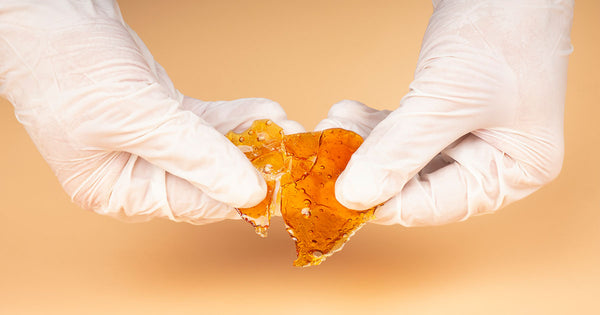The Quest for Purity - Pros and Cons of CRC Cannabis Filter Media
Feb 28, 2023

In the world of cannabis extraction, color remediation is a crucial step in achieving high-quality, aesthetically pleasing concentrates. The purpose of this process is to remove unwanted compounds that affect its color and taste, leaving behind a clear, pure product. One of the most vital tools for decolorizing extracts is the color remediation column (CRC), which uses various filter media to achieve this goal.
In this filer media guide, we will compare every filter media used in the CRC process, from activated charcoal to degumming enzymes. This will give you a comprehensive understanding of the pros and cons of each option, helping you make an informed decision on what filter media to use in your facility.
Bringing Out the Best with Color Remediation

Color remediation is a crucial step in the process of producing crystal-clear cannabis concentrates. Color remediation is used to remove any unnecessary pigments or undesirables from the extract, resulting in a final product that is pure, potent, and free from unappealing aromas and color bodies.
Color remediation involves running the extract through a series of filter media in a CRC, to trap and remove impurities and other unwanted substances. The process produces a cleaner and clearer concentrate that is ready for use in edibles, vape pens, and other infused products.
The importance of color remediation cannot be overstated. Chlorophyll and other pigments can have negative effects on the quality and potency of the extract, affecting both the taste and the effectiveness of the concentrate. By using a CRC, extractors can ensure that their extract is of the highest quality, providing their customers with a product that they can trust.
The Secret Sauce: CRC Filter Media Is Key to Pristine Extracts
Filter media is the material that is used in the process of color remediation in cannabis filtration. Its inherent properties, such as porosity and surface area, enable it to trap impurities through an adsorption process, where contaminants stick onto the solid-state stationary phase during a chromatography separation process.
There are several types of filter media available, each with its own unique properties and characteristics that make it suitable for use in a specific situation. Filter media can come in many forms including powders, beads, or granules.
The right filter media can make all the difference in the quality of the end product. For example, some filter media are more effective at removing chlorophyll, while others are better suited at removing pesticides. Different filter media can also impact the taste and color of the extract.
Activated Charcoal

Activated charcoal, also known as activated carbon, is commonly used in color remediation due to its ability to remove impurities. This filter media is made by heating carbon sources, such as coconut shells and bamboo, to high temperatures to create porous surfaces that are able to trap and hold onto chlorophyll and other pigments, which can be especially useful in ethanol extraction.
Activated charcoal is a powerful filter media that removes chlorophyll but can run the risk of removing valuable cannabinoids and terpenes from the process. With low-quality activated charcoal, there is a greater chance of heavy metals seeping into the end product.
Pros:
- Effective at removing pesticides and color
- Improves the taste and aroma of the extract
- Removes the haze and clarifies the product
- Large surface area
- Widely available
- Affordable
Cons:
- Can reduce potency and yield
- Slow filtering process
- Does not remove every contaminant
- Needs to be baked before using
- Very fine particulate matter makes it more hazardous and requires respiratory protection
Activated Magnesium Silicate
Activated magnesium silicate (MagSil-PR) is a powerful pesticide and color remediator, removing the oil’s haze and clarifying extracts with minimal yield loss. Activated magnesium silicate binds to water-soluble compounds.
Activated magnesium silicate can be used to separate the fats and lipids due to the size of its particles, while maintaining a high flow rate. It is recommended to use alongside activated bleaching clay (T-41) for better filtration.
Pros:
- Effective at removing pesticides and colors
- Expansive surface area
- Can remove lipids and fats
- Compatible with high flow rate systems
Cons:
- Pricier than other filter media
- Works better with additional filter media
Activated Bentonite Clay
Activated bentonite clay, also known as T-5, is commonly used to decolorize and purify cannabis concentrates. Activated bentonite clay’s acid activated properties allow it to effectively remove anthocyanin
pigments and chlorophyll.
Although the filtration takes a little longer than other filter media, it can produce clearer and lighter-colored extracts as a filter aid. As a cost-effective filter media, it is commonly used to remove pesticides and purify oils and is used for distillation and winterization.
Activated bentonite is usually used with activated carbon or silica to improve the purification efficiency. It can improve the overall removal of heavy metals and pesticides.
Pros:
- Neutral pH level
- Affordable
- Effective at removing color
Cons:
- Slow filtration
- Not ready-to-use
- Required respiratory protection
- Potential for residual clay particulate left in product
Silica Gel

Silica gel is a porous type of silicon dioxide, composed of oxygen and silicon atoms with microscopic pores, where contaminants can be trapped. Silica gel is usually used with other filter media such as activated bentonite clay to decolorize extracts.
Due to its low moisture level, it’s used as a drying agent in food, electronics, clothes, and pharmaceuticals.
Silica gel filter media does not limit your run times or efficiency. They work seamlessly with high-flow rate systems and are affordable enough to incorporate into your operating procedures.
Pros:
- Effective at removing colors and polar contaminants
- Compatible with high-flow systems
- Affordable
- Low Media : Biomass ratio
Cons:
- May reduce yield
- May dilute or strip out terpenes
- Requires respiratory protection
- Requires the use of complementary filter media
Activated Alumina
Activated alumina is made by dehydroxylating aluminum hydroxide, creating a material with high porosity and surface area. This filter media can be used to improve the filtration process or as a desiccant in many industrial applications.
Activated alumina is commonly used to purify polluted rainwater and groundwater, and other toxic areas. As a desiccant, it’s used to dry and lustrate natural gas and hydrogen peroxide.
In cannabis filtration, activated alumina is effective at removing yellow and red pigments, as well as fats and polar compounds. Activated alumina is an efficient filter aid due to many characteristics, including high crush resistance and stability.
Activated alumina is best used in conjunction with a granular filter media like CRY to improve overall filtration efficiency. When used in combination with other filter media, activated alumina can help remove some initial fats and color compounds, allowing the other media to focus on color removal.
Pros:
- Safe to work with
- No leaking into end product
- Effective at removing fats, colors, and polar compounds
- Substantial surface area
- Cost-effective
Cons:
- Breaks down at high temperatures
- Can affect oil stability if overused
Degumming Enzyme
The enzymatic degumming of cannabis oil is often used as an initial stage of the refining process to remove polar impurities and contaminants that can oxidize.
A relatively small amount of degumming enzyme, a phospholipid powder, can be used as the top layer during the remediation process to break down phospholipids (gums), triglycerides, and sugar lipids.
This organic and non-toxic process removes phospholipids through hydration, breaking down the gums without using acids or alkalines. Its natural approach makes it a great option for producing edible oils.
Manufacturers recommend winterizing the product after the degumming process, since the filtration process produces by-products, such as fatty acids. Enzymatic activity works best at 104º F (40º C) with 7.5 pH water. Avoid going over 122º F (50º C).
Pros:
- Environmentally friendly
- Improved overall filtration efficiency
- Easy to use
- Affordable
- Improved product stability
- Removes plant gums, as well as other contaminants, such as some metals
Cons:
- Requires proper storage to avoid denaturing the enzymes
- May require changes in pH
- Operates best at a certain temperature
- Requires additional filter media filtration
Activated Bleaching Clay
Activated bleaching clay, also known as T-41, is an acid-activated bentonite clay. The filter media has a high amount of carbon (10% carbon-to-clay ratio) and a low pH. It is usually used to purify oils, prepare oils before distillation, and remove pesticides and odors.
Pros:
- Effective at removing pigments, heavy metals, and other contaminants
- Can remove pesticides alongside magnesium silicate
Cons:
- Slow filtration process
- Not as affordable as other filter media
- Requires complementary filter media for better filtration
- Potential for carbon and clay particulate contamination
Diatomaceous Earth

Diatomaceous earth, also known as diatomite, are made from the fossilized remains of diatoms, which are single-cell algae. Diatoms are highly porous and offer a low resistance to flow, ensuring it provides excellent filtration.
Diatomaceous earth is a popular filter media used in the production of consumables, such as beer, wine, juices, oils, and more. It’s commonly used in swimming pool filter media and the filtration of biodiesel.
The filter media removes solids and other impurities due to its honeycomb-like structure. The small pores can trap contaminants and suspended solids, providing you with a more pure and less hazy product. Its unique structure enables the filtration of contaminants while allowing a fast flow rate.
Pros:
- High porosity
- Enables fast flow rates
- Natural sources good for consumables
- Affordable
- Widely available
- Removes plant waxes and lipids
- Improves clarity (reduces haze) and purity
- Allows for longer filtration runs
Cons:
- Requires PPE
- Can irritate lungs, so requires respiratory protection
- Fine particulates
- Needs baked before use
- May result in product loss
- Can be difficult to deal with
Unleash the Full Flavor and Aroma with Media Bros’ Filter Media
At Media Bros, we specialize in the production of cutting-edge filter media specifically designed for the cannabis extraction process. Our filter media is designed to be highly adsorbent and effective at removing colors, pesticides, and other contaminants, without reducing flavor or yield.
BHO
CRX: For fresh, high grade material where preservation is key, CRX is ready-to-use in high-flow systems, without the risk of clogging.
CRX Medium Flow: As an alternative to CRX, this medium flow version has a finer consistency to reduce channeling and clogging with a medium-flow and high-pressure system.
CRY: For stubborn colors, CRY amps up the embedded silica content to decolorize and clarify extracts made from aged or improperly stored biomass.
CRY Medium Flow: As an alternative to CRY, the CRY medium flow option is slightly finer to reduce channeling and is able to work with slightly higher psi.
CR41: For pre-distillation cleanup, the CR41 is pH neutral and compatible with a fast flow system to remove color, smoke, heavy metals, and pesticides.
Activated Alumina: Remove phospholipids and other plant surfactants, while clarifying the oil, with the ph neutral Color Remediation Alumina Granular (CRAG) filter media. It also helps improve winterization.
G-CRAC (Activated Carbon): Remove color, smoke, pesticides, heavy metals, and contaminants from extracts with Granular Color Remediation Activated Carbon (G-CRAC). The chunky particles provide faster and more efficient filtration than fine, carbon powder media.
Silica Gel 60A: Level up your inline CRC or post-processing with Silica Gel 60A to remove pesticides, heavy metals, and color pigments.
K-CRAC (Activated Carbon): For higher end extracts, use the “Kleanup” Color Remediation Activated Carbon (K-CRAC) to remove pesticides, color bodies, and other contaminants.
CO2
CO2 extraction is a popular method for producing cannabis concentrates, as it is safe, efficient, and environmentally friendly. However, like any extraction method, it has its drawbacks. CO2 extraction can leave behind a bitter taste that can affect the quality of the final product.
CR2 filter media from Media Bros is a non-toxic and non-reactive blend of naturally-occurring zeolites, capable of absorbing a high amount of unwanted compounds, even at high flow rates without clogging and removing the distinct CO2 taste.
Ethanol
Ethanol is a popular solvent for producing cannabis concentrates, as it is efficient at extracting the desired compounds from the plant material. However, it is also a strong solvent, meaning that it can leave behind residual impurities and solvents that can affect the quality of the final product.
Enter Media Bros' Color Remediation Activated Carbon (CRAC) filter media. This innovative filter media is specifically designed to remove residual impurities from ethanol extracts. It is pH neutral and double activated, making it highly effective at trapping and removing impurities.
Choosing the Best CRC Filter Media for Your Facility
Finding high-performance filter media for your facility will ultimately depend on several factors, including the type of extraction method you are using, the desired quality of the extract, and your budget.
Some filter media may be more effective than others depending on the type of extraction method you are using, while others may be more affordable but less effective. Ultimately, it is important to consider all of these factors when choosing the best CRC filter media for your facility.
The CRC battle for the best filter media for cannabis extraction is ongoing, with each media having its own pros and cons. Whether you choose activated charcoal, activated alumina, or any other filter media, be sure to conduct thorough research and testing to determine which media is best for your specific needs.
Filter Media Sample Request
Interested in trying our filter media? We would love to send you some! Browse our products, then fill out this form and someone from our team will be in touch to finalize your request.







